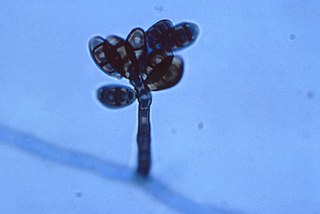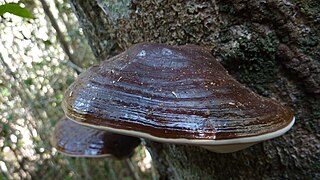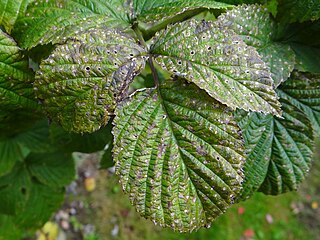The Westerdijk Institute, or Westerdijk Fungal Biodiversity Institute, is part of the Royal Netherlands Academy of Arts and Sciences. The institute was renamed on 10 February 2017, after Johanna Westerdijk, the first female professor in the Netherlands and director of the institute from 1907 to 1958. The former name of the institute was CBS-KNAW Fungal Biodiversity Centre or Centraalbureau voor Schimmelcultures. Despite the name change the collection maintained by the institute remains the CBS collections and the use of CBS numbers for the strains continues.

Curvularia is a genus of hyphomycete (mold) fungi which can be pathogens but also act as beneficial partners of many plant species. They are common in soil. Most Curvularia species are found in tropical regions, though a few are found in temperate zones.

Cochliobolus miyabeanus is a fungus that causes brown spot disease in rice.

The fungal genus Cochliobolus includes 19 species, it includes some plant pathogenic species such as Cochliobolus heterostrophus. A lot of former Cochliobolus species were transferred to either Curvularia or Bipolaris genera.
Gibellina cerealis is a fungal plant pathogen. It is a pathogen of wheat and similar species, causing white foot rot or basal stem rot.
Aphanomyces raphani, also known as Radish black root disease, is a fungal plant pathogen of various species of Brassicaceae. It is a necrotrophic pathogen causing small black water soaked lesions on its hosts which become rapidly colonised by other fungi and bacteria.
Septoria humuli is a fungal plant pathogen infecting the hop plant.
Septoria lactucae, or lettuce septoria blight, is a pathogenic leaf fungus that is found on lettuce.

Cochliobolus carbonum is one of more than 40 species of filamentous ascomycetes belonging to the genus Cochliobolus. This pathogen has a worldwide distribution, with reports from Australia, Brazil, Cambodia, Canada, China, Congo, Denmark, Egypt, India, Kenya, New Zealand, Nigeria, Solomon Islands, and the United States. Cochliobolus carbonum is one of the most aggressive members of this genus infecting sorghum, corn and apple. As one of the most devastating pathogens of sweet corn, C. carbonum causes Northern leaf spot and ear rot disease while the asexual stage causes Helminthosporium corn leaf spot. Cochliobolus carbonum is pathogenic to all organs of the corn plant including root, stalk, ear, kernel, and sheath. However, symptoms of infection show distinct manifestations in different plant parts: whole plant - seedling blight affects the whole plant, leaf discoloration and mycelial growth, black fungal spores and lesions appear on inflorescences and glumes, and grain covered with very dark brown to black mycelium which gives a characteristic charcoal appearance due to the production of conidia.
Cochliobolus cymbopogonis is a fungal plant pathogen. Those fungi that do not need a partner to mate are termed homothallic (self-fertile). C. cymbopogonis is homothallic.

Cochliobolus heterostrophus is a fungal plant pathogen. It can cause southern corn leaf blight in maize.

Cochliobolus lunatus is a fungal plant pathogen that can cause disease in humans and other animals. The anamorph of this fungus is known as Curvularia lunata, while C. lunatus denotes the teleomorph or sexual stage. They are, however, the same biological entity. C. lunatus is the most commonly reported species in clinical cases of reported Cochliobolus infection.

Ganoderma tornatum is a fungal plant pathogen in the genus Ganoderma. It is a species of basidiomycete fungi in the family Polyporaceae. Members are also known as bracket fungi, or polypores.
Phacidiopycnis padwickii is a species of fungus in the family Phacidiaceae, first described by Kavasji Framaji Kheswalla in 1941. It is a plant pathogen that causes collar rot, foot rot, wilt and blight of chickpea.

Mycosphaerella rubi is a fungal plant pathogen.
Uromyces musae is a fungal species and plant pathogen infecting bananas.
Haplobasidion musae, also known as the Malayan leaf spot, is an ascomycete fungus that is a plant pathogen. It was first described M. B. Ellis in 1957.

Pleosporaceae is a family of sac fungi. They are pathogenic to humans or saprobic on woody and dead herbaceous stems or leaves.

Fungivory or mycophagy is the process of organisms consuming fungi. Many different organisms have been recorded to gain their energy from consuming fungi, including birds, mammals, insects, plants, amoebas, gastropods, nematodes, bacteria and other fungi. Some of these, which only eat fungi, are called fungivores whereas others eat fungi as only part of their diet, being omnivores.

A fungus is any member of the group of eukaryotic organisms that includes microorganisms such as yeasts and molds, as well as the more familiar mushrooms. These organisms are classified as one of the traditional eukaryotic kingdoms, along with Animalia, Plantae and either Protista or Protozoa and Chromista.









